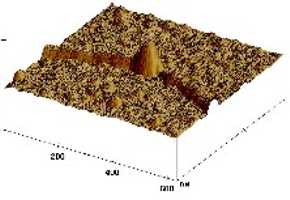
Centre for NanoScience, Ludwig-Maximilians-University, Butenandtst. 5-13, D-81377 München, Germany
e-mail: kotthaus@cens.de
URL: http://www.nano.physik.uni-muenchen.de
URL: http://www.cens.de

 |
Jörg P. Kotthaus*
Centre for NanoScience, Ludwig-Maximilians-University, Butenandtst. 5-13, D-81377 München, Germany e-mail: kotthaus@cens.de URL: http://www.nano.physik.uni-muenchen.de URL: http://www.cens.de |
 |
With the steady reduction of electronic devices to nanometer dimension new methods are desired to combine top-down lithography-based fabrication with directed bottom-up assembly. Several attempts to utilize the selective binding properties of biomolecules to assemble nanoelectronic devices will be discussed. Combining streptavidin-biotin linker chemistry with functionalized carbon nanotubes is employed to self-assemble single-molecule-based hybrid devices, which can be individually provided with lithographically fabricated electric contacts. At low temperatures the resulting 3-terminal devices exhibit Coulomb blockade behavior characteristic for single electron transport. DNA-templates are combined with conducting polymers in an attempt to realize simple self-assembling nanoscale electronic devices such as nanowires. The resulting nanowire assemblies are characterized by AFM imaging and current-voltage studies. Alternatively nanofabrication techniques can also be utilized to address biomedical problems. As an example a lab-on-a-chip system replacing traditional patch-clamping is discussed which allows to study ion transport through cell walls both in a whole cell geometry as well as through individual ion channels.
*In cooperation with Udo Beierlein, Stefan Beyer, Wendy Dittmer, Niels Fertig, Patrick Nickels, Friedrich Simmel, and Tobias Smorodin